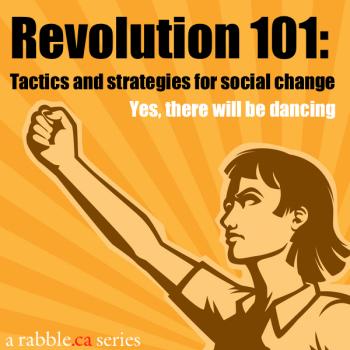Summer is here and whether you feel it or not the planet is getting hotter. The movement for climate justice has surged along with the rise of global dependence on fossil fuels, the rising acidity of oceans and fracking. In Robin Tress’ article on creative and direct action, she says:
A good action tells a story, and a good story has a moral or lesson. Activists can and should create a story that shows the lesson they’re trying to teach. In the cases of both of these actions, and many other events within the climate justice movement, the moral of the story was that climate change is not a fight against pollution, it’s a fight against polluters, and those polluters have names and addresses.
Telling the story of resistance and demanding eco-justice is no easy feat. Organizing Cools the Planet: Reflections to Navigate the Climate Crisis is an awesome activist-created resource to start with. There are also fantastic resources on Smart Meme, to help create a narrative story for campaigns and actions. Here are other tools for creative direction actions to take climate justice campaigns to the masses.
Organizing a direct action
Direct actions take the struggles of folks straight to the source. It’s a physical action — a demonstration, a rally, a march and so on. Direct actions can be difficult to gauge and plan for effectiveness. Some actions attract a lot of people but work towards building awareness rather than concrete next steps. Other actions are symbolic art to demonstrate hypocrisies in policy. The first step is to decide what the goals of the direct action will be. Depending on what the desired outcome is, different actions will be more effective. If the goal is to get lots of people out, the action and process might be different than if the goal is just to attract media attention to a campaign. Once the goals of the action are clear, organizers can explore different ideas. Using creative techniques like theatre as protest and other artistically inspired actions help separate campaigns from the crowd.
Recruit and reach out
Every good direct action has the ability to mobilize folks for a cause. Use this guide to recruiting new activists to help get the word out. Publicizing the direct action ensures that folks will actually show up. Exploit the mainstream media, contact alternative media (like rabble.ca!) and other like-minded groups to help represent the interlocking oppressions within the overall issue. Social media is invaluable at reaching out to folks, reminding them and giving others who can’t attend constant updates during the action.
Accessibility
Direct actions rely on people coming out to “do activism” in a physical space — even though there are many institutional, physical and social barriers to participating. Organizers should try to recognize and work against as many of these barriers as possible. To make marches more accessible, try to offer transportation for folks with mobility issues who can’t walk long distances and arrange for ASL interpreters if there will be speakers for members of the Deaf community. Try to offer food, water, transit fare and childcare to help folks who normally might not be able to attend. These barriers can seem difficult to overcome when a campaign has limited resources but they aren’t impossible to work around. Maybe other activists have babysitting experience or access to a vehicle through friends — networking with community resources can help fill some of these gaps.
Safety
During direct actions, certain folks are also more vulnerable to criminalization than others. Organizers should try to ensure that everyone who attends can stay safe. This guide to safety for trans folks during direct actions can also help inform allies. Training legal observers to monitor the direct action and take note of police interactions can also create a safer action. Make sure that before the action, everyone knows their basic rights. For large actions, this resource on street medics can help give organizers a basic understanding of event-based first aid. Having active listeners present can also help folks feel safer at an action. Active listeners can offer peer support and give feedback to organizers about the action afterwards.
What tools for direct actions do you use? What resources on climate justice did we miss? Let us know in the comments and add them to the Lynn Williams Activist Toolkit.
Steff Pinch is the coordinator of the Lynn Williams Activist Toolkit.




